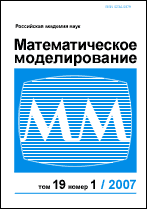|
This article is cited in 6 scientific papers (total in 6 papers)
Numerical modeling of the relaxation of a body behind the transmitted shock wave
D. A. Sidorenkoab, P. S. Utkinab
a Moscow Institute of Physics and Technology
b Institute for Computer Aided Design of Russian Academy of Sciences
Abstract:
The problem of a planar shock wave – cylinder with different mass interaction is considered. The cylinder can move translationally under the action of the pressure force. The statement qualitatively corresponds to the problem of a particle relaxation behind the transmitted shock wave. Mathematical model is based on two-dimensional Euler equations. Numerical algorithm is based on the Cartesian grid method for the simulations of flows in the areas with varying geometry. The algorithm and its program realization are tested on the problem about the lifting of the cylinder behind the transmitted shock wave. The curves of the cylinder speed variation in time are plotted. The explanations about the qualitative view of the curves for the different cylinders masses are given. For one mass the analysis of the dynamics of the relaxation process is carried out from the point of view of the non-stationary shock waves patterns that are realized as a result of shock wave – cylinder interaction.
Keywords:
shock wave, moving cylinder, numerical modeling, Cartesian grid method, Euler equations.
Received: 12.02.2018
Citation:
D. A. Sidorenko, P. S. Utkin, “Numerical modeling of the relaxation of a body behind the transmitted shock wave”, Mat. Model., 30:11 (2018), 91–104; Math. Models Comput. Simul., 11:4 (2019), 509–517
Linking options:
https://www.mathnet.ru/eng/mm4020 https://www.mathnet.ru/eng/mm/v30/i11/p91
|

| Statistics & downloads: |
| Abstract page: | 286 | | Full-text PDF : | 71 | | References: | 38 | | First page: | 6 |
|




 Contact us:
Contact us: Terms of Use
Terms of Use
 Registration to the website
Registration to the website Logotypes
Logotypes









 Citation in format
Citation in format 